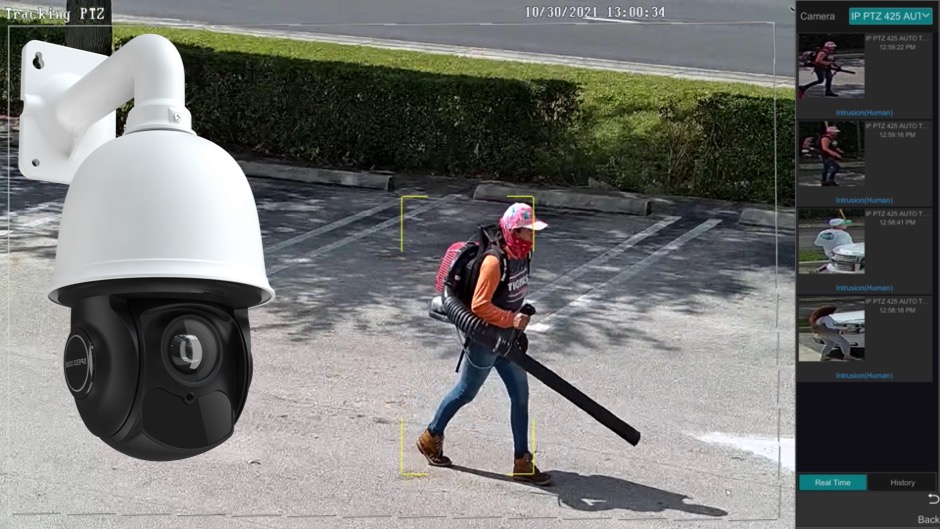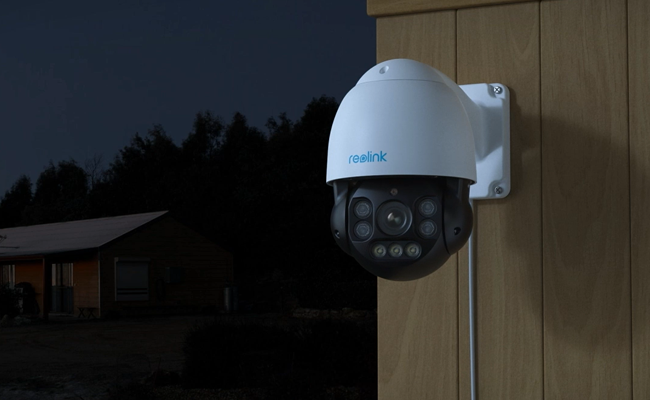A PTZ (Pan-Tilt-Zoom) security camera is a type of surveillance camera that can be remotely controlled to pan (move horizontally), tilt (move vertically), and zoom in or out to provide a wider range of coverage and greater detail. These cameras are commonly used in security systems to monitor large areas such as parking lots, warehouses, and outdoor spaces.
PTZ cameras can be controlled manually by a security operator or programmed to automatically track motion or follow pre-defined patterns. They are versatile and offer flexibility in surveillance monitoring. Read about How to Connect Security Camera to Wi-Fi
Importance of PTZ Security Cameras
In today’s security landscape, where threats come in various forms and from all directions, the need for comprehensive surveillance solutions has never been more critical. PTZ cameras address this need by providing unmatched versatility and coverage, making them indispensable tools for securing properties, assets, and public spaces.
How PTZ Security Cameras Work
Pan, Tilt, Zoom Functions
PTZ cameras are equipped with motors that allow them to pan horizontally, tilt vertically, and zoom in or out to capture detailed images across different distances. These movements can be controlled remotely via a computer, smartphone, or dedicated control panel. Discover about How to Turn Off Ring Camera
Remote Control Capabilities
One of the defining features of PTZ cameras is their remote control capabilities, which enable users to manipulate the camera’s movements and zoom levels from virtually anywhere with an internet connection. This flexibility is especially valuable in situations where real-time monitoring and response are paramount.
Features of PTZ Security Cameras
Optical Zoom vs. Digital Zoom
PTZ cameras typically offer both optical and digital zoom capabilities. Optical zoom provides superior image quality by adjusting the lens’s focal length, while digital zoom enhances the image digitally but may result in some loss of quality.
Preset Positions
Many PTZ cameras allow users to program preset positions, enabling the camera to automatically move to specific locations or angles with the push of a button. This feature is particularly useful for surveillance of large areas or for monitoring multiple points of interest. Learn about Light Bulb Security Camera
Motion Tracking
Some advanced PTZ cameras feature motion tracking technology, which automatically detects and follows moving objects within the camera’s field of view. This ensures that potential threats or suspicious activity are continuously monitored and recorded.

Night Vision
To maintain surveillance capabilities in low-light or nighttime conditions, many PTZ cameras are equipped with infrared (IR) LEDs or low-light imaging sensors. These technologies enable the camera to capture clear, high-resolution images even in complete darkness.
Weatherproofing
Given that many PTZ cameras are installed outdoors for surveillance purposes, weatherproofing is a crucial feature to consider. Weatherproof PTZ cameras are designed to withstand harsh environmental conditions such as rain, snow, and extreme temperatures, ensuring uninterrupted operation year-round.
Applications of PTZ Security Cameras
Home Security
In residential settings, PTZ cameras offer homeowners peace of mind by providing comprehensive surveillance coverage of their property. From monitoring entry points such as doors and windows to keeping an eye on outdoor spaces like gardens and driveways, PTZ cameras serve as a reliable deterrent against intruders and burglars.
Business Security
For businesses of all sizes, security is a top priority to protect assets, employees, and customers. PTZ cameras are invaluable assets in this regard, offering flexible surveillance solutions for monitoring entrances, parking lots, warehouses, and other key areas of interest.
Public Spaces Surveillance
In public spaces such as parks, shopping malls, and transportation hubs, ensuring the safety and security of visitors is paramount. PTZ cameras play a crucial role in these environments, enabling authorities to monitor crowds, detect suspicious behavior, and respond promptly to emergencies.
Traffic Monitoring
On roads and highways, PTZ cameras are used for traffic monitoring and management purposes. These cameras provide real-time updates on traffic conditions, accidents, and congestion, allowing transportation authorities to make informed decisions and improve overall road safety.
Benefits of Using PTZ Security Cameras
Enhanced Surveillance Coverage
Unlike fixed cameras with limited field of view, PTZ cameras offer 360-degree coverage and the ability to zoom in on specific areas of interest. This ensures that no corner goes unnoticed, providing comprehensive surveillance coverage of the entire premises.
Real-time Monitoring
With PTZ cameras, users can monitor live video feeds in real-time, enabling prompt action in response to potential threats or security breaches. Whether it’s detecting unauthorized access, monitoring suspicious behavior, or identifying individuals, PTZ cameras empower users with actionable intelligence when it matters most.
Deterrence of Criminal Activity
The presence of PTZ cameras alone acts as a powerful deterrent against criminal activity. Knowing that their actions are being recorded and monitored, potential intruders are less likely to attempt unauthorized entry or engage in unlawful behavior, effectively reducing the risk of security incidents.
Considerations When Choosing PTZ Security Cameras
Budget
PTZ cameras come in a range of prices, from budget-friendly options to high-end models with advanced features. It’s essential to determine your budget and prioritize features that align with your security needs and objectives.
Resolution
Image resolution is a critical factor to consider when choosing PTZ cameras, as it directly impacts the clarity and detail of captured footage. Higher resolution cameras produce sharper images and are better equipped to capture essential details such as facial features and license plate numbers.
Pan and Tilt Range
The pan and tilt range of PTZ cameras determines the extent to which they can move horizontally and vertically. Cameras with wider ranges offer greater flexibility in terms of surveillance coverage, allowing users to monitor larger areas with fewer cameras.
Zoom Capabilities
Zoom capabilities, both optical and digital, play a significant role in the effectiveness of PTZ cameras. Cameras with powerful zoom lenses can capture detailed images of distant objects without sacrificing image quality, making them ideal for long-range surveillance applications.
Compatibility with Existing Systems
When integrating PTZ cameras into an existing security system, compatibility is crucial to ensure seamless operation and integration with other devices and software platforms. It’s essential to choose cameras that are compatible with your existing infrastructure and meet your system’s technical requirements.
Installation and Maintenance of PTZ Security Cameras
Proper Placement
The placement of PTZ cameras is critical to maximizing their effectiveness and coverage. Cameras should be strategically positioned to cover key areas of interest while minimizing blind spots and obstructions.
Regular Maintenance Checks
To ensure optimal performance and longevity, PTZ cameras require regular maintenance checks and servicing. This includes cleaning the lenses, checking for any physical damage or signs of wear and tear, and updating firmware and software as needed.
PTZ Security Cameras vs. Fixed Cameras
Flexibility and Coverage
While fixed cameras offer simplicity and reliability, they lack the flexibility and coverage provided by PTZ cameras. PTZ cameras can pan, tilt, and zoom to capture detailed images across a wide area, making them ideal for monitoring large spaces or tracking moving objects.
Cost Comparison
In terms of upfront costs, PTZ cameras are typically more expensive than fixed cameras due to their motorized mechanisms and advanced features. However, when considering the broader scope of coverage and functionality they offer, PTZ cameras may provide a more cost-effective solution in the long run.
Suitability for Different Environments
Fixed cameras are well-suited for stationary surveillance applications where a fixed field of view suffices. In contrast, PTZ cameras excel in dynamic environments where real-time monitoring and flexible coverage are essential, such as outdoor areas, industrial facilities, and public spaces.

Challenges and Limitations of PTZ Security Cameras
Vulnerability to Vandalism
PTZ cameras, particularly those installed in outdoor environments, are susceptible to vandalism and tampering. Proper installation measures, such as mounting cameras out of reach and using protective enclosures, can mitigate this risk to some extent.
Potential Motion Blur
Fast-moving objects or sudden changes in direction can cause motion blur in PTZ camera footage, reducing image clarity and effectiveness. To minimize this issue, cameras with higher frame rates and advanced image stabilization capabilities are recommended.
Complexity of Installation and Setup
Installing and configuring PTZ cameras can be more complex compared to fixed cameras, requiring additional expertise and technical knowledge. Proper planning, including site surveys and system design, is essential to ensure optimal performance and functionality.
Future Trends in PTZ Security Camera Technology
Integration with AI and Machine Learning
The integration of artificial intelligence (AI) and machine learning (ML) technologies is poised to revolutionize the capabilities of PTZ cameras. AI-powered analytics can enhance object detection, facial recognition, and behavioral analysis, enabling more proactive and intelligent surveillance systems.

Enhanced Resolution and Imaging Capabilities
Advancements in imaging technology continue to push the boundaries of resolution and image quality in PTZ cameras. Ultra-high-definition (UHD) and 4K cameras are becoming increasingly common, providing unparalleled clarity and detail in captured footage.
Improved Durability and Weather Resistance
As demands for outdoor surveillance solutions grow, PTZ cameras are evolving to withstand harsh environmental conditions with improved durability and weather resistance features. From ruggedized enclosures to advanced sealing techniques, these cameras ensure reliable operation in any climate.
Conclusion
PTZ security camera represent the pinnacle of surveillance technology, offering unmatched flexibility, control, and coverage for a wide range of security applications. From homes and businesses to public spaces and transportation networks, PTZ cameras play a vital role in safeguarding assets, deterring criminal activity, and enhancing overall security.
FAQs
- What does PTZ stand for in PTZ security cameras?
- PTZ stands for Pan, Tilt, and Zoom, referring to the motorized movements and zoom capabilities of these cameras.
- Can PTZ cameras be controlled remotely?
- Yes, PTZ cameras can be controlled remotely via a computer, smartphone, or dedicated control panel, allowing users to adjust the camera’s movements and zoom levels from anywhere with an internet connection.
- Are PTZ cameras suitable for outdoor use?
- Many PTZ cameras are specifically designed for outdoor use, with features such as weatherproofing, ruggedized enclosures, and infrared night vision capabilities to withstand harsh environmental conditions.
- How do PTZ cameras differ from fixed cameras?
- Unlike fixed cameras with a stationary field of view, PTZ cameras offer pan, tilt, and zoom capabilities, allowing users to adjust the camera’s orientation and focal length to capture detailed images across a wide area.
- What are some common challenges when using PTZ cameras?
- Common challenges when using PTZ cameras include vulnerability to vandalism, potential motion blur in fast-moving scenes, and the complexity of installation and setup compared to fixed cameras.
